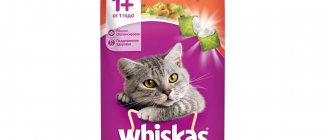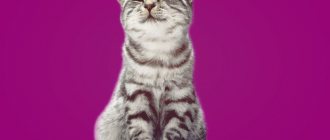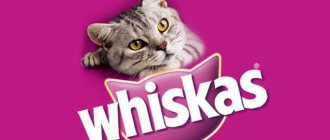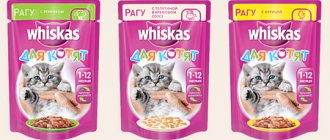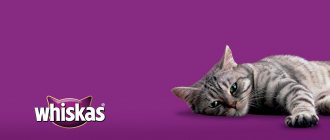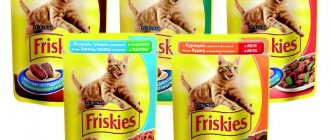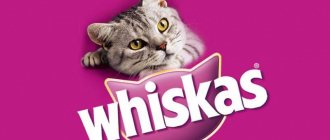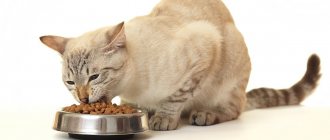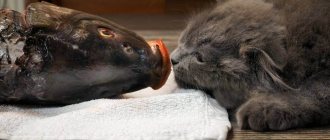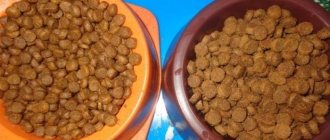4306Administration
Due to the lack of time among owners and their stereotype that the kitten does not get everything it needs from natural products, ready-made dry and soft food has gained popularity. Almost everyone who has a kitten for the first time is interested in whether Whiskas is good for kittens as a permanent diet. This food belongs to the economy category, and this makes it clear that you cannot count on high quality. Not all components of this food are indicated on the packaging, and therefore the owner has little idea what the kitten, which is completely dependent on his care, is eating.
Composition information
There is an opinion that economy class food contains only harmful products.
However, the pets themselves love Whiskas and eat it with pleasure.
A detailed analysis of the composition will allow you to determine whether Whiskas is healthy.
Let's look at the composition of Whiskas Kitten Chicken Stew:
- The total amount of protein is 8.3 grams (per 100 grams), which is insufficient for normal growth and development of a kitten. The source of protein is chicken, however, there is no more than 4% meat, the rest is by-products.
- Cereals are indicated as the source of carbohydrates, but there is no indication of which ones or their percentage.
- The source of fat is vegetable oil without a specified exact amount.
- The manufacturer lists taurine as an additional substance. This is an essential amino acid that is not produced independently in the pet’s body. It also contains vitamins and minerals.
- The composition turned out to be blurry, which indicates the low quality of the product.
Brand history
The Whiskas brand has been on the market since 1958. Now every developed country has a representative office of this brand, and you can buy finished products in almost any store. The same cannot be said about some other brands for cats, which are sold only in specialized pet stores.
Cat whiskey
Note! Cat owners began to call food from other manufacturers “Whiskas.” The name has become a common noun.
This is interesting: Symptoms of an allergy to cat fur
Alternative
From a physiological point of view, a natural diet based on meat and cereals is more useful. The intestines of a predator are adapted for processing hard protein foods; soft foods cause digestive disorders and lead to tooth damage. Proper natural feeding requires a lot of time and expense.
Most owners feed their pets with ready-made food. Their advantages:
- provide balanced nutrition;
- facilitate the calculation of the required calorie intake;
- have a long shelf life.
Dry food is divided according to quality into the following groups:
- Economy class - Friskies, Kitekat. Contains 5% protein, a large amount of starch, preservatives.
- Premium class - Royal Canin, Proplan, Brit Premium. Includes animal and plant proteins 30-40%, preservatives. The composition is clearly indicated on the packaging. Average price 600 rub. for 1.5 kg.
- Super premium class - Brit Care, Bozita. Proteins of animal origin at least 40%. Average price 900 rub. for 2 kg.
- Holistics - Acana, Applaws, Grandorf. Contains up to 90% quality meat and fats. Average price 1200 rub. for 2 kg.
Large packages are usually cheaper.
If it is impossible to buy quality food, natural food will be preferable to harmful crackers with an artificial taste.
Some cats, having become dependent on Whiskas, flatly refuse to eat other food. You need to wean your animal off harmful products gradually by adding high-quality food to the diet. Start with minimal amounts that are invisible to the pet, gradually reducing the proportion of Whiskas. In 2-3 months you can painlessly wean your cat off junk food.
The harmfulness of Whiskas for cats and kittens is undeniable. The gloomy joke of veterinarians that as long as economy-class food exists, they will not face unemployment is not at all funny. Pets cannot choose their own food. It is the owner's responsibility to provide a safe and nutritious diet.
What are the consequences
Feeding your pet with ready-made food is quite simple, quick and inexpensive. However, few owners think about the possible consequences of such a diet for their pet.
Veterinarians point to the following diseases and pathological conditions that develop in cats whose menu is based on Whiskas and other economy-class foods:
- gastritis;
- ulcerative lesions of the gastrointestinal tract;
- bouts of vomiting;
- liver pathologies;
- development of dependence on food, refusal of other foods;
- kidney diseases;
- sand and stone formations localized in the kidney area;
- hair loss;
- skin, dermatological diseases;
- lethargy, passivity;
- development of obesity;
- the appearance of dandruff and skin rashes;
- pancreatitis.
Clinical studies have shown that cats fed Whiskas require more water. Thus, when eating 100 g of food, an animal must consume at least 250 ml of liquid, which is virtually unrealistic. Lack of proper drinking regime leads to serious problems with the kidneys and urination, increased urine concentration, and the formation of sand and stones.
If you constantly feed Whiskas to a small kitten, you can provoke delays in its development, a weakened immune system and an increased susceptibility to various kinds of diseases. Possible unwanted side effects include allergic reactions.
The results of the studies have proven that domestic cats that feed exclusively on Whiskas and often consume this food live on average no more than 5 years. At the same time, the average life expectancy of cats whose owners provide an optimally balanced menu is at least 10-15 years.
Herbivores (cows, horses, sheep, antelopes and others)
Their body is maximally adapted to digest carbohydrates and other nutrients obtained from plants.
2:2242
All herbivores are characterized by common anatomical features:
2:128
- the structure of molars (flat and rectangular), ideally suited for grinding and crushing coarse plant stems. The lateral mobility of the lower jaw (from side to side) is clearly expressed, facilitating chewing movements that promote chewing of plants
- long digestive tract - the length of the intestines can be almost 10 times the length of your own body, which ensures better absorption of indigestible fiber, which is rich in plant foods
- Saliva contains the enzyme amylase, which helps digest carbohydrates. Therefore, herbivores chew vegetation thoroughly to ensure that it is mixed with amylase.
Cons of Whiskas for kittens
The disadvantages of Whiskas food directly relate to the condition of the animal. If you feed it such food, the kitten’s health will deteriorate quickly. A cat raised on Whiskas will not be able to live a full life, even if in the future it is transferred to high-quality feeding with natural food. The main disadvantages of Whiskas food, which the kitten will not tolerate without consequences, are the following :
- poor-quality composition that does not satisfy all the cat’s needs for vitamins, microelements and proteins - with such a diet the animal cannot fully develop. Even if, at first glance, the kitten grows well, receiving only Whiskas as the main food, its internal organs are not formed correctly, because of this, serious health problems will soon begin;
- provoking the development of urolithiasis due to an increase in the concentration of mineral salts in the urine - this phenomenon is due to the fact that normally for every 100g of food eaten, the kitten should drink 1 glass of water immediately after eating, which is impossible for him to do completely. Thus, a kitten gradually becomes ill with urolithiasis from childhood;
- addictive chemical components - the kitten becomes addicted to the substances included in Whiskas, from which it is very difficult to transfer it to normal nutrition, which is necessary to maintain health.
Having studied the disadvantages that Whiskas kitten food has, any owner will understand that, of course, you should not choose such a diet for your pet. A kitten will grow healthy only with adequate nutrition.
Product range
Whiskas is available in dry and wet forms (portioned bags). The main components of the composition are: chicken, rabbit, lamb or other ingredients.
All offers are divided according to age. There are separate lines for kittens, adults and elderly pets (over 7 years old). Filtering allows you to take into account all the features in different age periods.
For kittens
Whiskas offers several food options for kittens. A dry product is produced in pillows, as well as wet types - pate and stew in portioned bags. You can feed a kitten from 1 month of age. Up to 4 weeks, you cannot feed your baby this food, giving preference to mother's milk or special milk formulas.
Whiskas for kittens is represented by the following assortment:
- Turkey flavored jelly.
- Salmon flavored stew.
- Veal jelly.
- Chicken flavored pate.
- Pads with milk and turkey.
For adult pets
Whiskas also has a wide range of dry and wet food for adult cats.
This line is intended for feeding animals after 1 year.
All products can be divided into several main categories:
- Wet food in the form of a stew with different flavors. The main ingredients can be salmon, rabbit, turkey, beef. One bag can contain several flavors (for example, beef and lamb).
- Mini fillets with different flavors. Pieces of fillet are combined with jelly here. The meat base is chicken, beef or rabbit.
- Cream soup with beef or chicken. The liquid consistency helps improve digestion and prevents constipation.
- Jelly with fish, chicken, rabbit and vegetables.
- Pate with fish or poultry, beef, veal.
- The manufacturer produces pillows with pate in the form of a dry product.
- There is a separate line for spayed and neutered pets. These animals have special needs and require a special diet. Therefore, before castration or deciding to sterilize a pet, you need to take care of changing its menu.
Another type of food is treats, which are not recommended to be given daily.
Bagged food for cats: what is it made from and how much to give per day?
join the discussion
Share with your friends
Pets are an integral part of our lives. Their health and emotional state directly depend on what they eat. What is the currently popular cat food pouch made from? How to properly feed it to your furry friends? We will answer these questions in detail.
How much to give per day?
Firstly, it is better to choose one brand of food for your cat and not experiment further.
A pet does not need a constant change of food, since its stomach and intestines may react negatively to such an experiment.
Secondly, to choose the daily amount of such food for your cat, you need to check the directions on the pack. For example, for an average-sized cat weighing 3-4 kg, 3-4 80 gram bags of food are needed. And a pregnant furry pet already needs 5 sachets.
A newly born pet should be given special food for kittens. It is higher in calories, and its pieces are smaller than regular ones. Each pack also contains the recommended daily dose.
Wet food should not be placed all in a bowl at once. It should be heated in small portions to room temperature, and the opened jar or bag should be stored in the refrigerator for no more than a day. Unfinished food should be immediately put into the refrigerator, as pathogenic bacteria multiply very quickly in it.
How many meat pouches should a cat eat per day?
My cat does not eat anything except meat bags (like Whiskas, Kiteket, Friskas, etc.). What is the daily intake? The cat is outbred, small in size, 3 years old. Just no matter how much you give her, she will eat everything and therefore it is impossible to understand whether she is feeling hungry or is just being capricious.
Author of the publication
Anastasia
Achievement received 10/08/2018
Similar:
The selection of food, including meat bags, must be approached individually, and it all depends on the animal’s taste preferences, energy expenditure, and individual metabolism. Typically, on the food packaging, the dosage is indicated depending on the cat’s weight and activity level, and you can use it as a guide. And so, each cat is characterized by a “buffet”, that is, it can approach the cup up to 16 times a day, and it will always have an increased appetite. So that this does not become expensive for the owner, then you need to meat bags, or divide the food into 4 feeding times, and give it out strictly according to the norm. In case the cat's fur is dull and he looks thin despite the food, this means that he does not have enough nutrition and will need to increase its amount. In general, in order to know for sure how much food an animal needs, for this you need to give it a large portion of food, and then weigh the uneaten food, so you will know how much it needs at a time. Cats rarely overeat, but if the animal is neutered, it eats twice as much.
This is interesting: Sketch of a tattoo on the arm for girls
My cat and I had the same problem. But the veterinarians told us that this is due to the fact that we feed the cat fish. Although we have another cat who eats the same thing and he hasn't had the same problem.
I have the exact same cat, only a little older. And he also doesn’t eat anything other than wet food. We'll soon go broke feeding him. We give him according to his gluttony. And everything is fine, we don’t complain about anything, he goes to the toilet regularly. Previously they gave it 4 times a day. Now, he started eating more. Whatever he asks for, we give it to him.
I usually don’t give my cat the whole bag at once, but only half, and put the remaining half in the refrigerator. After a while I give half the bag again. Two sachets or one and a half per day. If he really asks, then I’ll give him three, if he’s particularly gluttonous. Her appetite is not constant, sometimes she does not eat at all. At the same time, dry food is a must, and plenty of fresh water. Moreover, tastes change - sometimes she loves pate, sometimes she refuses, the same goes for jelly and cream soup. She also has to change companies - either she likes Whiskas or Felix. Or she just eats fried fish and doesn’t need any bags. But as much as you give, you eat as much - I haven’t noticed that. If she’s full, the food on the saucer will simply dry out, and she won’t touch it. I have to throw it away. Although it is greedy, and I tell her that transferring money to her is empty, and we are not millionaires. Only the cat doesn’t understand my complaints about money. And fresh food should be available on demand, at the first meow. But more often she is patient, she just stays nearby and watches. Waiting for me to guess.
On these meat bags with cat food, I don’t remember exactly what brand, but they are all about the same, it says that they are designed for two feedings. As the veterinarian told us, the healthiest food for a cat is food from his own table. That's why cats now eat the same things we eat. Soups, meat, chicken, fish, eggs, cottage cheese: a complete and varied diet. You can also give them porridge; in the wild, they receive a certain amount of grains in the gastrointestinal tract of the rodents they catch. I also buy these bags, but I don’t feed them all the time. They are kept as a reserve when there is no time to cook, so the cat receives a semi-finished product. In general, it is not advisable to feed a cat only commercially produced food. Monosodium glutanate is added to these foods, which is a flavor enhancer, so the cat eats the food with such appetite. But in terms of impact on health, it is not very useful. As correctly written above, it can provoke urolithiasis.
I feel sorry for the bird - in this case the cat - how dependent he is on the homo sapiens who tamed him. A stingy man's tear flows in an incessant stream from my bright eyes:
